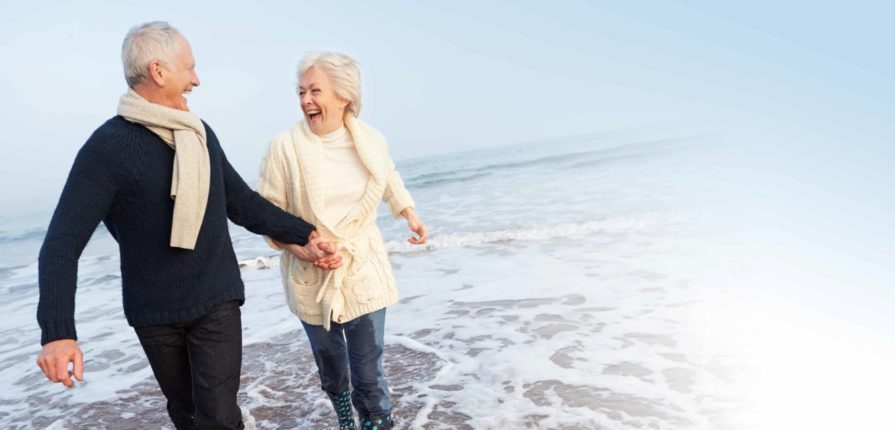October is Breast Cancer Awareness Month, but did you know that World Osteoporosis Day is every October?
Now’s the time to learn if you’re at risk for osteoporosis and what you can do about it.
It’s called the “silent disease” because, without regular screening, you won’t know you have it until you break something. A wrist. A hip. An arm. A vertebra in your back.
It’s osteoporosis and it affects one out of ten women aged 60, two out of ten aged 70, four out of ten aged 80; and two out of three aged 90 and older. 1 One in three women aged 60 and older will experience a fracture in her lifetime.
Men are not immune, with a higher risk of experiencing an osteoporosis-related fracture than getting prostate cancer. In fact, one in five men aged 60 and older will experience a fracture.1
Bone is a living tissue, continually breaking down and being built back up. Osteoporosis occurs when bone breaks down faster than it can be built up. The result is increasingly fragile bone marked by so many holes it may look like lace. That, in turn leads to fractures. Worldwide, one third of women and one fifth of men over 50 will experience osteoporotic fractures. In fact, women over 45 spend more days in the hospital with an osteoporotic fracture than for diabetes, heart attack, or breast cancer.1
When young, a hip or arm fracture not be such a big deal. But with osteoporosis, it’s not just about a broken bone, but about the challenges in that bone healing. That’s why a fracture when you’re older can lead to a downward spiral into a nursing home and even death.
While you can’t control one of the major risk factors for osteoporosis—age—there are numerous things you can do to reduce your risk of disability and death from this disease.
Assess your risk. Risk factors for osteoporosis include: having close family members with it (did your grandmother have the classic “dowager’s hump”?); breaking a bone after age 50; early menopause; and physical inactivity most of your life.1 Learn your own risk for the disease here.
Get moving. That means more than just walking. Resistance training options span the gamut between from lifting dumbbells and working with exercise bands, to using the weight machines at your gym. Or simply use your body weight for push-ups and planks.
Prevent falls. The majority of hip fractures occur because of a fall. You can fall-proof your home with just a few changes listed here.
Eat a bone-healthy diet. That means foods high in calcium. Sure, there’s dairy; but don’t forget about eggs, tuna, shrimp, lentils, beans, and numerous vegetables. Track your calcium intake and find calcium-rich foods with the International Osteoporosis Foundation’s calcium calculator.
Take your supplements. Without Vitamin D bone cannot absorb calcium. Most of our vitamin D comes from sunshine; however, those who live in northern climes and/or use sunscreen may be deficient. Current recommendations are 600 IU/day for women ages 51 to 70, and 800 IU/day for those 71 and older.2 If your diet is not high in calcium-rich foods, consider calcium supplements as well.
Don’t smoke. A great deal of evidence shows that smoking weakens bones and increases risk of fractures. So talk to your doctor about a plan to quit – there’s just as much evidence that once your quit, your bones recover.3
Moderate alcohol intake. Heavy drinking can reduce estrogen production in premenopausal women and reduce levels of testosterone in men (both hormones are important for bone health). It also interferes with the body’s ability to use calcium and vitamin D.
And importantly… Get your bones screened. A bone mineral density test involves a simple and painless body scan that will identify weakening bone at its earliest stages. Performed using a low-dose x-ray scan, a bone mineral density (BMD) test is recommended for women beginning at age 65 and for men beginning at age 70. If you’ve broken a bone after age 50 or have genetic risk factors, consult with your doctor.
By identifying weakening bone at its earliest stages, effective treatment can help you reduce your risk of fracture. Different studies have consistently shown that, depending on the drug and the patient population, treatment reduces the risk of vertebral fracture by between 30-70%, nonvertebral fractures by between 15-20%, and hip fractures up to 40%.1
References
1. International Osteoporosis Foundation. Facts and Statistics. 2019; https://www.iofbonehealth.org/facts-statistics. Accessed October 17, 2019.
2. National Institutes of Health: Office of Dietary Supplements. Vitamin D. 2019; https://ods.od.nih.gov/factsheets/VitaminD-HealthProfessional/. Accessed September 26, 2019.
3. Al-Bashaireh AM, Haddad LG, Weaver M, Chengguo X, Kelly DL, Yoon S. The Effect of Tobacco Smoking on Bone Mass: An Overview of Pathophysiologic Mechanisms. Journal of Osteoporosis. 2018;2018:17.




Leave a Reply